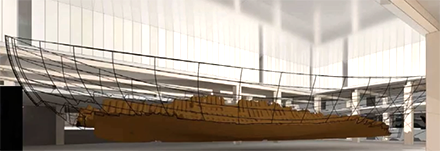The final pieces of what has been compared to a huge, heavy but also very delicate 3D medieval puzzle are being returned to the Welsh city where they were found in riverside mud two decades ago. Source: The Guardian
Now experts can look forward to putting back together the 2,500 or so pieces of timber and finding a long-term home for the amazing object they will form a 15th-century sailing ship.
Since the remains of the Newport medieval ship were discovered during a building project for the city’s Riverfront theatre in 2002, conservation specialists have been painstakingly preserving the timbers.
A significant milestone as the final batch of oak and beech timbers are transported back to Wales from Portsmouth, where experts involved in the preservation of the Mary Rose have been working their magic.
“It’s very exciting,” said Sian King, the vice-chair of the Friends of the Newport Ship on Thursday. “This is a key moment and it will be good to have all the pieces back.”
The next stage of the project will be to begin the complex reassembly of the dried and treated timbers.
Newport city council will undertake a feasibility study into finding a permanent home for the ship, hoping that ultimately the project will provide a huge tourism boost as people visit the Welsh answer to the Mary Rose.
Due to the size of the vessel and the complexity of the reassembly process it cannot be permanently housed in its current home, a Newport warehouse, or at the city’s museum and art gallery.
Jane Mudd, the leader of the council and cabinet member for economic growth and strategic investment, said: “I’m delighted that the latest stage of the project to conserve and reassemble the Newport medieval ship has been successfully completed. The ship is a significant piece of Newport’s history.
“Newport has so much to offer, and we want to celebrate our history and culture and ensure that it is preserved so that future generations know our story.”
The ship was a three-masted craft measuring more than 30 metres in length and capable of carrying about 200 tonnes of cargo. Examination of the artefacts found onboard suggests it probably sailed the Lisbon to Bristol trade route.
Through the study of tree-ring data, it has been concluded that the trees used to construct the ship were felled around 1449 in the Basque Country. It was brought to Newport for repairs or refit in about 1469 but was taken to bits after being damaged when a cradle supporting it collapsed and it did not sail again.








